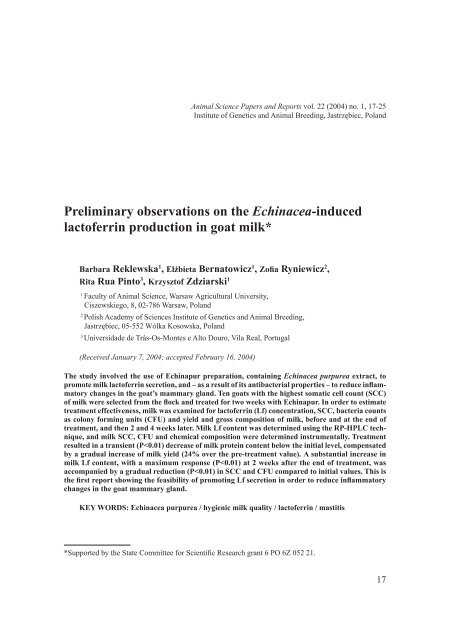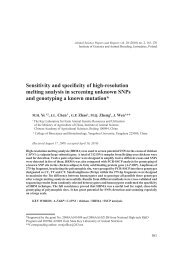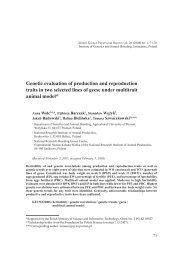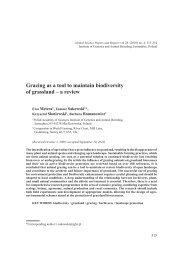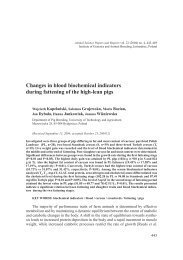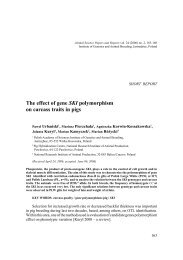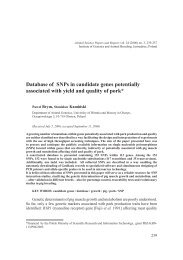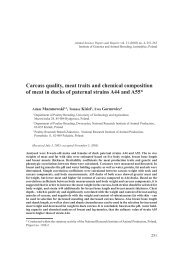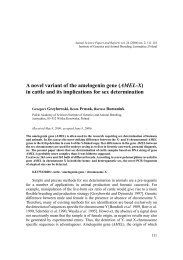Preliminary observations on the Echinacea-induced lactoferrin ...
Preliminary observations on the Echinacea-induced lactoferrin ...
Preliminary observations on the Echinacea-induced lactoferrin ...
You also want an ePaper? Increase the reach of your titles
YUMPU automatically turns print PDFs into web optimized ePapers that Google loves.
Animal Science Papers and Reports vol. 22 (2004) no. 1, 17-25<br />
Institute of Genetics and Animal Breeding, Jastrzębiec, Poland<br />
<str<strong>on</strong>g>Preliminary</str<strong>on</strong>g> <str<strong>on</strong>g>observati<strong>on</strong>s</str<strong>on</strong>g> <strong>on</strong> <strong>the</strong> <strong>Echinacea</strong>-<strong>induced</strong><br />
<strong>lactoferrin</strong> producti<strong>on</strong> in goat milk*<br />
Barbara Reklewska 1 , Elżbieta Bernatowicz 1 , Zofia Ryniewicz 2 ,<br />
Rita Rua Pinto 3 , Krzysztof Zdziarski 1<br />
1<br />
Faculty of Animal Science, Warsaw Agricultural University,<br />
Ciszewskiego, 8, 02-786 Warsaw, Poland<br />
2<br />
Polish Academy of Sciences Institute of Genetics and Animal Breeding,<br />
Jastrzębiec, 05-552 Wólka Kosowska, Poland<br />
3<br />
Universidade de Trás-Os-M<strong>on</strong>tes e Alto Douro, Vila Real, Portugal<br />
(Received January 7, 2004; accepted February 16, 2004)<br />
The study involved <strong>the</strong> use of Echinapur preparati<strong>on</strong>, c<strong>on</strong>taining <strong>Echinacea</strong> purpurea extract, to<br />
promote milk <strong>lactoferrin</strong> secreti<strong>on</strong>, and – as a result of its antibacterial properties – to reduce inflammatory<br />
changes in <strong>the</strong> goat’s mammary gland. Ten goats with <strong>the</strong> highest somatic cell count (SCC)<br />
of milk were selected from <strong>the</strong> flock and treated for two weeks with Echinapur. In order to estimate<br />
treatment effectiveness, milk was examined for <strong>lactoferrin</strong> (Lf) c<strong>on</strong>centrati<strong>on</strong>, SCC, bacteria counts<br />
as col<strong>on</strong>y forming units (CFU) and yield and gross compositi<strong>on</strong> of milk, before and at <strong>the</strong> end of<br />
treatment, and <strong>the</strong>n 2 and 4 weeks later. Milk Lf c<strong>on</strong>tent was determined using <strong>the</strong> RP-HPLC technique,<br />
and milk SCC, CFU and chemical compositi<strong>on</strong> were determined instrumentally. Treatment<br />
resulted in a transient (P
B. Reklewska et al.<br />
Producers and c<strong>on</strong>sumers are both becoming increasingly interested in goat’s milk.<br />
C<strong>on</strong>sumers are attracted by its high digestibility, low allergenicity and beneficial chemical<br />
compositi<strong>on</strong>, more similar to human than to cow’s milk. Producers are attracted by<br />
<strong>the</strong> hope of easier access to <strong>the</strong> market of goat than of cow’s milk, producti<strong>on</strong> of <strong>the</strong><br />
latter being restricted by quotas, as well as by <strong>the</strong> possibility of making luxury cheeses<br />
sold at increased prices.<br />
The main problem for goat milk producers is <strong>the</strong> difficulty in following <strong>the</strong> hygiene<br />
standards, particularly as regards somatic cell count (SCC) – Zeng and Escobar [1996].<br />
Due to <strong>the</strong> different mode of milk secreti<strong>on</strong> [Paape 2000], <strong>the</strong> goat milk SCC can be<br />
much higher than that of cows’ milk. Despite increasing <strong>the</strong> legal limit of milk SCC<br />
from 500 × 10 3 /cm 3 to 1 mill./cm 3 , many producers from various countries are unable<br />
to fulfil even this c<strong>on</strong>diti<strong>on</strong> [Zeng 1996]. Meanwhile, <strong>the</strong> European market is setting<br />
ever higher standards for animal products. They should be not <strong>on</strong>ly fresh and tasty,<br />
but also safe and healthy. Programmes to improve <strong>the</strong> hygienic quality of milk are not<br />
fully effective, particularly in <strong>the</strong> case of goat milk. Simultaneously, improvement is<br />
hindered by a lack of a specific criteri<strong>on</strong> for goats, to discriminate between milk from<br />
healthy or sick animals [Paape 2000, Wils<strong>on</strong> et al. 1995].<br />
The over-use of antibiotics in humans and animals observed in recent years, has<br />
led to a rapid rise in <strong>the</strong> number of bacteria strains resistant to <strong>the</strong> majority of antibiotics,<br />
which makes infecti<strong>on</strong> even harder to c<strong>on</strong>trol [Tan et al. 2000].<br />
The withdrawal of antibiotics from animal producti<strong>on</strong>, which awaits us in <strong>the</strong> future,<br />
is a reas<strong>on</strong> to seek alternative soluti<strong>on</strong>s. One of <strong>the</strong>se is c<strong>on</strong>cerned with making<br />
use of <strong>the</strong> organism’s own defence system. The secretory cells of <strong>the</strong> mammary gland<br />
produce and secrete casein and a range of whey proteins, <strong>on</strong>ly recently recognized<br />
as important functi<strong>on</strong>al comp<strong>on</strong>ents of dairy products. One of <strong>the</strong>m – <strong>lactoferrin</strong> – is<br />
particularly noteworthy. Lactoferrin is present in most body fluids of mammals, and<br />
has l<strong>on</strong>g been known for its ability to bind ir<strong>on</strong> [Wilce and Aguilar 1991]. At present,<br />
<strong>lactoferrin</strong> is known to have anti-bacterial, anti-viral, anti-fungal, anti-carcinogenic,<br />
and immuno-stimulating properties [Bellamy et al. 1992, Bezault et al. 1994, Dial et<br />
al. 1998, Vorland 1999, Shimazaki 2000, Tsuda et al. 2000, Gardiner 2001] and is used<br />
for treatment of various c<strong>on</strong>diti<strong>on</strong>s. The activity of <strong>lactoferrin</strong> is, however, not high,<br />
and commercial preparati<strong>on</strong>s available are expensive [Shimazaki 2000].<br />
The present experiment aimed at establishing <strong>the</strong> possibility of promoting milk<br />
<strong>lactoferrin</strong> producti<strong>on</strong> with Echinapur preparati<strong>on</strong>, and improving <strong>the</strong> health status of <strong>the</strong><br />
mammary gland by stimulating <strong>the</strong> goats’ own defence system. The preparati<strong>on</strong> c<strong>on</strong>tains<br />
an extract of <strong>Echinacea</strong> purpurea, which has proven ability to activate <strong>the</strong> immune system<br />
[Burger et al. 1997, Chang 2000]. In studies performed <strong>on</strong> healthy volunteers <strong>the</strong> <strong>Echinacea</strong><br />
purpurea enhanced phagocytic activity of polymorph<strong>on</strong>uclear neutrophils [Chang<br />
2000]. Macrophages in <strong>the</strong> presence of <strong>Echinacea</strong> purpurea produced significantly more<br />
cytokines and interfer<strong>on</strong>e than did unstimulated cells [Burger et al. 1997].<br />
18<br />
Material and methods
<strong>Echinacea</strong>-<strong>induced</strong> <strong>lactoferrin</strong> producti<strong>on</strong> in goat milk<br />
The experiment was carried out at <strong>the</strong> Polish Academy of Sciences Institute of<br />
Genetics and Animal Breeding, Jastrzębiec, <strong>on</strong> Polish White Improved (upgraded)<br />
goats. Out of a flock of 30, 10 animals in <strong>the</strong> initial stages of lactati<strong>on</strong> were chosen<br />
with <strong>the</strong> highest somatic cell count (SCC) of milk. During <strong>the</strong> experiment, all animals<br />
were kept in pens, and fed indoors. The diet was composed of 1.2 kg of c<strong>on</strong>centrates,<br />
2.5-3.0 kg of haylage and 1 kg hay. Echinapur pills (Herbapol, Poland), c<strong>on</strong>taining<br />
<strong>Echinacea</strong> purpurea extract were given over two weeks in starch capsules, twice daily,<br />
during milking. The daily dose of Echinapur applied was suitable for an adult man,<br />
i.e. 6 pills, each c<strong>on</strong>taining 100 mg of extract, being equal to 2 mg active substance<br />
(polyphenol acids) per pill. The effectiveness of Echinapur was established <strong>on</strong> <strong>the</strong> basis<br />
of its effect <strong>on</strong> <strong>the</strong> SCC/cm 3 milk, total number of milk bacteria, expressed as col<strong>on</strong>y<br />
forming units (CFU/cm 3 ), and <strong>lactoferrin</strong> (Lf) c<strong>on</strong>tent of milk.<br />
The SCC, CFU and Lf c<strong>on</strong>tent were determined in milk samples taken four times:<br />
before <strong>the</strong> start of treatment (initial level), immediately after administrati<strong>on</strong> <strong>the</strong> last<br />
dose (final level), and <strong>the</strong>n two and four weeks after terminati<strong>on</strong> of <strong>the</strong> treatment. Milk<br />
samples were subjected to routine analysis for protein, fat, lactose and dry matter using<br />
Milkoscan FT 120 (Foss Electric). The SCCs were determined with <strong>the</strong> Somacount<br />
150 (Bentley) and CFUs using spiral inoculati<strong>on</strong> in <strong>the</strong> WASP (Bentley) and<br />
automatic scanning with <strong>the</strong> CounterMat Flash 4.2 (Bentley).<br />
The Lf c<strong>on</strong>tent of milk was measured using reverse-phase liquid chromatography<br />
(RP-HPLC), with Agilent 1100 chromatograph, equipped with a UV detector and Supelcosil<br />
RP-C18 column, 4.6 × 250 mm and pore diameter of 5 µm (Supelco). The<br />
separati<strong>on</strong> of whey proteins was based <strong>on</strong> methods described by Romero et al. [1996]<br />
and Wilce and Aguilar [1991]. Standard bovine Lf of 90% purity (SIGMA) was used<br />
as reference protein.<br />
The results were assessed with <strong>the</strong> least squares method using <strong>the</strong> general linear<br />
model – GLM, according to SAS procedure [SAS 1992]. In <strong>on</strong>e goat, with <strong>the</strong> highest<br />
SCC, clinical mastitis developed <strong>on</strong>e day after <strong>the</strong> start of <strong>the</strong> experiment and antibiotic<br />
treatment was necessary. The animal was not included in <strong>the</strong> statistical evaluati<strong>on</strong> of<br />
results.<br />
The results were assessed with a least squares method according to SAS [1992]<br />
procedure using <strong>the</strong> general linear model (GLM) and taking into account <strong>the</strong> effect of<br />
<strong>the</strong> time of sampling, regressi<strong>on</strong> <strong>on</strong> <strong>the</strong> day of lactati<strong>on</strong>, and random error.<br />
Results and discussi<strong>on</strong><br />
Administering of Echinapur did not affect significantly milk yield, as well as lactose<br />
and dry matter c<strong>on</strong>tent. A small transient but significant decrease in <strong>the</strong> protein<br />
and an increase in fat c<strong>on</strong>tent were observed. However, 14 days after <strong>the</strong> last dose of<br />
Echinapur has been administered, <strong>the</strong> protein c<strong>on</strong>tent of milk increased (Tab. 1) and<br />
finally reached <strong>the</strong> level higher (P
B. Reklewska et al.<br />
rise of milk yield compared to initial level (P
<strong>Echinacea</strong>-<strong>induced</strong> <strong>lactoferrin</strong> producti<strong>on</strong> in goat milk<br />
[Dymnicka et al. 2003] given daily 300 g of dried whole plant <strong>Echinacea</strong> purpurea per<br />
animal over three weeks, significant changes were observed nei<strong>the</strong>r in milk SCC nor in<br />
<strong>the</strong> level of milk immunoglobulins. However, <strong>the</strong> effectiveness of <strong>Echinacea</strong> purpurea<br />
immuno-modulating activity may vary according to envir<strong>on</strong>mental c<strong>on</strong>diti<strong>on</strong>s of plant<br />
growth, as well as to <strong>the</strong> method of herb c<strong>on</strong>servati<strong>on</strong>. No informati<strong>on</strong> was available<br />
c<strong>on</strong>cerning <strong>the</strong> level of active comp<strong>on</strong>ents in <strong>Echinacea</strong> purpurea administered to cows<br />
by Dymnicka et al. [2003].<br />
The positive results of this study <strong>on</strong> Echinapur administrati<strong>on</strong> to goats at doses<br />
recommended for humans allow to anticipate that <strong>Echinacea</strong> purpurea extract may be<br />
used effectively in treating <strong>the</strong> sub-clinical mastitis in ruminants. However, although<br />
<strong>Echinacea</strong> has a proven effect <strong>on</strong> <strong>the</strong> immune system [Burger et al. 1997, Chang 2000]<br />
and its active c<strong>on</strong>stituents have been identified, its mechanism of acti<strong>on</strong> still remains<br />
unknown [Percival 2000].<br />
Beneficial effect of administering Echinapur to cows has also been observed <strong>on</strong><br />
CFU/cm 3 of milk (Tab. 2). As a result of <strong>the</strong> two-week <strong>the</strong>rapy <strong>the</strong> decrease (67.9% of<br />
<strong>the</strong> initial amount) in <strong>the</strong> total CFUs in milk was found (P
B. Reklewska et al.<br />
syn<strong>the</strong>sized in <strong>the</strong> secretory cells of <strong>the</strong> mammary gland [Sanchez et al. 1992] and by<br />
leukocytes [Levay and Viljoen 1995]. Thus, in order to find out whe<strong>the</strong>r <strong>the</strong> immunity<br />
stimulati<strong>on</strong> resulted from increased Lf producti<strong>on</strong> milk Lf level in <strong>the</strong> treated goats<br />
was measured (Tab. 3).<br />
The initial Lf level of milk ranged from 10.27 to 52.77 mg/l what is similar to values<br />
reported by Schanbacher et al. [1993, 1997] for mature cow milk (10-100 µg/ml), but<br />
lower than those given by Palmano and Elgar [2002] or Hamann and Krömker [1997].<br />
C<strong>on</strong>trary to colostrum, where <strong>the</strong> level of Lf exceeds even by 100% <strong>the</strong> values found<br />
in advanced lactati<strong>on</strong> [Levay and Viljoen 1995], <strong>the</strong> milk Lf can reach very high level<br />
during involuti<strong>on</strong> of <strong>the</strong> bovine mammary gland [Schanbacher et al. 1993]. It should,<br />
however, be emphasized that all <strong>the</strong> authors menti<strong>on</strong>ed refer to quite old informati<strong>on</strong><br />
by Mass<strong>on</strong> and Heremans from 1971 as cited by Recio and Visser [2000].<br />
Mastitis provokes an immune resp<strong>on</strong>se. The entry of bacteria into <strong>the</strong> gland<br />
through <strong>the</strong> teat canal evokes an increase in <strong>the</strong> number of leukocytes. Lf, as <strong>the</strong> main<br />
anti-bacterial whey protein, is produced both by <strong>the</strong> gland and <strong>the</strong> increased number<br />
of leukocytes, to fight infecti<strong>on</strong>. When infecti<strong>on</strong> has already been c<strong>on</strong>trolled, <strong>the</strong> milk<br />
Lf level decreases [Harm<strong>on</strong> 1994]. The changes of Lf c<strong>on</strong>centrati<strong>on</strong> of milk of goat<br />
437 (Tab. 3) strictly reflect <strong>the</strong> way <strong>the</strong> change occurs as described by Harm<strong>on</strong> [1994].<br />
Goats receiving Echinapur (with <strong>the</strong> excepti<strong>on</strong> of no. 437, which had clinical mastitis)<br />
produced milk c<strong>on</strong>taining significantly more Lf than before treatment.<br />
During 14 days after <strong>the</strong> treatment of Echinapur was terminated, <strong>the</strong> Lf c<strong>on</strong>tent of<br />
milk kept increasing (P
<strong>Echinacea</strong>-<strong>induced</strong> <strong>lactoferrin</strong> producti<strong>on</strong> in goat milk<br />
fur<strong>the</strong>r studies <strong>on</strong> animals are necessary in order to establish <strong>the</strong> optimum period of<br />
treatment, as well as <strong>the</strong> safe and effective daily dose of <strong>Echinacea</strong> purpurea, in whatever<br />
form it may be. The easiest and cheapest would be <strong>the</strong> use of dried plants. However,<br />
establishing <strong>the</strong> level of active ingredients of <strong>Echinacea</strong> purpurea depending <strong>on</strong> <strong>the</strong><br />
phase and c<strong>on</strong>diti<strong>on</strong>s of growth and drying would be a problem.<br />
It can be c<strong>on</strong>cluded that <strong>the</strong> efficiency of Echinapur preparati<strong>on</strong> exceeded <strong>the</strong> expectati<strong>on</strong>s.<br />
A significant rise of Lf c<strong>on</strong>tent of milk as a result of stimulating <strong>the</strong> immune<br />
system of goats with <strong>Echinacea</strong> purpurea extract may provide a model for producti<strong>on</strong><br />
of milk with increased anti-bacterial properties. A significant lowering in SCC and CFU<br />
in milk of goats receiving Echinapur points to <strong>the</strong> feasibility of using <strong>the</strong> preparati<strong>on</strong><br />
to achieve beneficial changes in health of <strong>the</strong> mammary gland, and simultaneously an<br />
improvement in <strong>the</strong> hygienic and health-promoting quality of milk. The preparati<strong>on</strong><br />
does not induce negative changes in <strong>the</strong> c<strong>on</strong>tent of basic milk comp<strong>on</strong>ents with <strong>the</strong><br />
excepti<strong>on</strong> of a transient but significant decrease of <strong>the</strong> protein c<strong>on</strong>tent.<br />
Although <strong>the</strong> results presented here must be treated as preliminary, <strong>the</strong>y suggest <strong>the</strong><br />
potential feasibility of applicati<strong>on</strong> of <strong>Echinacea</strong> as a immunostimulating feed additive.<br />
REFERENCES<br />
1. BELLAMY W., TAKASE M., YAMAUCHI K., WAKABAYASHI H., KAWASE K., TOMITA M.,<br />
1992 – Identificati<strong>on</strong> of <strong>the</strong> bactericidal domain of <strong>lactoferrin</strong>. Biochimica et Biophysica Acta 1121,<br />
130-136.<br />
2. BEZAULT J., BHIMANI R., WIPROVNICK J., FURMANSKI P., 1994 – Human <strong>lactoferrin</strong> inhibits<br />
growth of solid tumors and development of experimental metastases in mice. Cancer Research 54,<br />
2310-2312<br />
3. BURGER R.A., TORRES A.R., WARREN R.P., CALDWELL V.D., HUGHES B.G., 1997 – <strong>Echinacea</strong>-<strong>induced</strong><br />
cytokine producti<strong>on</strong> by human macrophages, Internati<strong>on</strong>al Journal of Immunopharmacology<br />
7, 371-379.<br />
4. CHANG J., 2000 – Medicinal herbs: drugs or dietary supplements? Biochemical Pharmacology 59,<br />
211-219.<br />
23
B. Reklewska et al.<br />
5. DIAL E.J., HALL L.R., SERNA H., ROMERO J.J., FOX J.G., LICHTENBERGER L.M., 1998<br />
– Antibiotic properties of bovine <strong>lactoferrin</strong> <strong>on</strong> Helicobacter pylori. Digestive Diseases and Sciences<br />
43 (12), 2750-2756.<br />
6. DYMNICKA M., ŁOZICKI A., KOZIOROWSKI M., KLUPCZYŃSKI J., MICIŃSKI J., MŚCISZ<br />
A., 2003 – Effect of <strong>the</strong> additi<strong>on</strong> of dried <strong>Echinacea</strong> purpurea in <strong>the</strong> diet of cows <strong>on</strong> <strong>the</strong> c<strong>on</strong>tent of<br />
somatic cell in milk and <strong>the</strong> level of g-globulins in blood serum of cows and calves and in colostrums.<br />
Proceedings of <strong>the</strong> XXXII Polish Academy of Sciences Committee of Animal Producti<strong>on</strong> C<strong>on</strong>ference<br />
“Animal nutriti<strong>on</strong> and safety food producti<strong>on</strong>”. 14-15 September, Lublin, Poland. Abstract, p. 30.<br />
7. GARDINER T., 2001 – Biological activities of Lactoferrin. Glycoscience & Nutriti<strong>on</strong> 2 (3), 1-8.<br />
8. HAMANN J., KRÖMKER V., 1997 – Potential of specific milk compositi<strong>on</strong> variables for cow health<br />
management. Livestock Producti<strong>on</strong> Science 48, 201-208.<br />
9. HARMON R.J., 1994 – Physiology of mastitis and factors affecting somatic cell counts. Journal of<br />
Dairy Science 77, 2103-2112.<br />
10. HEINE W.E., KLEIN P.D., REEDS P.J., 1991 – The importance of alpha-lactoalbumin in infant<br />
nutriti<strong>on</strong>. Journal of Nutriti<strong>on</strong> 121, 277-283.<br />
11. IYER S., LONNERDAL B., 1993 – Lactoferrin, <strong>lactoferrin</strong> receptors and ir<strong>on</strong> metabolism. European<br />
Journal of Clinical Nutriti<strong>on</strong> 47, 232-241.<br />
12. LEVAY P.L., VILJOEN M., 1995 – Lactoferrin: A general review. Haematologica 80, 252-267.<br />
13. PAAPE M.J., 2000 – Situati<strong>on</strong> regarding <strong>the</strong> legal limit for somatic cell counts for goats in <strong>the</strong> United<br />
States. Proceedings of 7th Internati<strong>on</strong>al C<strong>on</strong>ferences <strong>on</strong> Goats. 15-21 May, INRA, Tours-Poitiers,<br />
France, 755-756.<br />
14. PALMANO K.P., ELGAR D.F., 2002 – Detecti<strong>on</strong> and quantificati<strong>on</strong> of <strong>lactoferrin</strong> in bovine whey<br />
samples by reverse-phase high-performance liquid chromatography <strong>on</strong> polystyrene-divinylbenzene.<br />
Journal of Chromatography A, 947, 307-311.<br />
15. PARK Y.W., HUMPHREY R.D., 1986 – Bacterial cell counts in goat milk and <strong>the</strong>ir correlati<strong>on</strong> with<br />
somatic cell counts, percent fat and protein. Journal of Dairy Science 69, 32-37.<br />
16. PERCIVAL S.S., 2000 – Use of <strong>Echinacea</strong> in medicine. Biochemical Pharmacology 60, 155-158.<br />
17. RECIO I., VISSER S., 2000 – Antibacterial and binding characteristics of bovine, ovine and caprine<br />
<strong>lactoferrin</strong>s: a comparative study. Internati<strong>on</strong>al Dairy Journal 10, 597-605.<br />
18. ROMERO C., PEREZ-ANDUJAR O., JIMENEZ S., 1996 – Detecti<strong>on</strong> of cow’s milk in ewe’s or<br />
goat’s milk by HPLC. Chromatographia 42, 181-184.<br />
19. SANCHEZ L., LUJAN L., ORIA R., CASTILLO H., PEREZ D., ENA J.M., CALVO M., 1992<br />
– Syn<strong>the</strong>sis of <strong>lactoferrin</strong> and transport of transferrin in <strong>the</strong> lactating mammary gland of sheep. Journal<br />
of Dairy Science 75, 1257-1262.<br />
20. SAS/STAT, 1992 – User’s guide release, 6.07 editi<strong>on</strong>. SAS Institute, Cary, NC.<br />
21. SCHANBACHER F.L., GOODMAN R.E., TALHOUK R.S., 1993 – Bovine mammary <strong>lactoferrin</strong>:<br />
implicati<strong>on</strong>s from messenger rib<strong>on</strong>ucleic acid (mRNA) sequence and regulati<strong>on</strong> c<strong>on</strong>trary to o<strong>the</strong>r milk<br />
proteins. Journal of Dairy Science 76, 3812-3831.<br />
22. SCHANBACHER F.L. TALHOUK R.S., MURRAY F.A., 1997 – Biology and origin of bioactive<br />
peptides in milk. Livestock Producti<strong>on</strong> Science 50, 105-123.<br />
23. SHIMAZAKI K., 2000 – Lactoferrin: A marvelous protein in milk. Animal Science Journal 71,<br />
329-347.<br />
24. ŚWIERCZEWSKA E., NIEMIEC J., NOWORYTA-GŁOWACKA J., 2003 – A note <strong>on</strong> <strong>the</strong> effect<br />
of immunostimulati<strong>on</strong> of laying hens <strong>on</strong> <strong>the</strong> lysozyme activity. Animal Science Papers and Reports<br />
21 (1), 63-68.<br />
25. TAN Y.T., TILLET D.J., MCKAY I.A., 2000 – Molecular strategies for overcoming antibiotic resistance<br />
in bacteria. Molecular Medicine Today 6, 309-313.<br />
24
<strong>Echinacea</strong>-<strong>induced</strong> <strong>lactoferrin</strong> producti<strong>on</strong> in goat milk<br />
26. TSUDA H., SEKINE K., USHIDA Y., KUHARA T., TAKASUKA N., IIGO M., HAN B.S.,<br />
MOORE M.A., 2000 – Milk and dairy products in cancer preventi<strong>on</strong>: focus <strong>on</strong> bovine <strong>lactoferrin</strong>.<br />
Mutati<strong>on</strong> Research 462, 227-233.<br />
27. VORLAND L.H., 1999 – Lactoferrin: a multifuncti<strong>on</strong>al glycoprotein. Acta Pathologica, Microbiologica<br />
et Immunologica Scandinavica 107, 971-981.<br />
28. WILCE M.C.J, AGUILAR M.I., 1991 – High-performance liquid chromatography of amino acids,<br />
peptides and proteins. Journal of Chromatography 536, 165-183.<br />
29. WILSON D.J., STEWART K.N., SEARS P.M., 1995 – Effects of stage of lactati<strong>on</strong>, producti<strong>on</strong>, parity<br />
and seas<strong>on</strong> <strong>on</strong> somatic cell counts in infected and uninfected dairy goats. Small Ruminant Research<br />
16, 165-169.<br />
30. ZENG S.S, ESCOBAR E.N., 1996 – Effect of breed and milking method <strong>on</strong> somatic cell count,<br />
standard plate count and compositi<strong>on</strong> of goat milk. Small Ruminant Research 19, 169-175.<br />
31. ZENG S.S., 1996 – Comparis<strong>on</strong> of goat milk standards with cow milk standards for analyses of<br />
somatic cell count, fat and protein in goat milk. Small Ruminant Research 21, 221-225.<br />
Barbara Reklewska, Elżbieta Bernatowicz,<br />
Zofia Ryniewicz, Rita Rua Pinto, Krzysztof Zdziarski<br />
Wstępne obserwacje nad pobudzeniem produkcji laktoferyny<br />
w mleku kozim za pomocą ekstraktu z <strong>Echinacea</strong> purpurea<br />
S t r e s z c z e n i e<br />
Badano zastosowanie preparatu Echinapur zawierającego ekstrakt jeżówki purpurowej (<strong>Echinacea</strong><br />
purpurea) do pobudzania sekrecji laktoferyny (Lf) w mleku i – w wyniku jej antybakteryjnych<br />
właściwości – zredukowania zmian zapalnych w gruczole mlekowym kóz. Ze stada wybrano 10 kóz z<br />
najwyższą liczbą komórek somatycznych (SCC) w mleku, którym przez 2 tygodnie podawano Echinapur.<br />
Jedno zwierzę wycofano z racji klinicznego mastitis i leczenia antybiotykiem. Dla oceny efektywności<br />
zastosowanego preparatu określano w mleku SCC, ogólną liczbę bakterii (CFU), poziom Lf oraz wydajność<br />
i podstawowy skład mleka przed i po zakończeniu podawania preparatu oraz po upływie dalszych 2 i 4<br />
tygodni. Zawartość Lf w mleku oznaczano metodą RP-HPLC a SCC i CFU metodami instrumentalnymi.<br />
Stwierdz<strong>on</strong>o przejściowe (P


